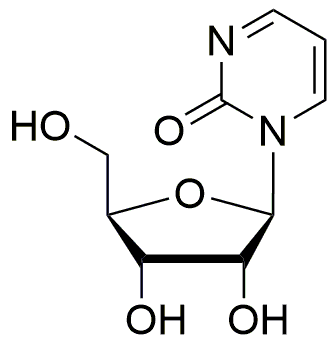Zebularine is widely utilized in research focused on:
- Cancer Research: Zebularine has shown promise as a hypomethylating agent, which can help reactivate silenced tumor suppressor genes, making it a valuable tool in developing cancer therapies.
- Epigenetics: This compound is used to study DNA methylation processes, providing insights into gene regulation and the potential for therapeutic interventions in various diseases.
- Drug Development: Researchers are exploring zebularine's ability to enhance the effectiveness of existing chemotherapeutic agents, potentially leading to more effective treatment regimens for cancer patients.
- Gene Therapy: Zebularine's role in modifying epigenetic markers makes it a candidate for gene therapy applications, particularly in conditions where gene expression needs to be altered.
- Neuroscience: Studies indicate that zebularine may influence neuronal differentiation and survival, suggesting potential applications in neurodegenerative disease research.
General Information
Properties
Safety and Regulations
Applications
Zebularine is widely utilized in research focused on:
- Cancer Research: Zebularine has shown promise as a hypomethylating agent, which can help reactivate silenced tumor suppressor genes, making it a valuable tool in developing cancer therapies.
- Epigenetics: This compound is used to study DNA methylation processes, providing insights into gene regulation and the potential for therapeutic interventions in various diseases.
- Drug Development: Researchers are exploring zebularine's ability to enhance the effectiveness of existing chemotherapeutic agents, potentially leading to more effective treatment regimens for cancer patients.
- Gene Therapy: Zebularine's role in modifying epigenetic markers makes it a candidate for gene therapy applications, particularly in conditions where gene expression needs to be altered.
- Neuroscience: Studies indicate that zebularine may influence neuronal differentiation and survival, suggesting potential applications in neurodegenerative disease research.
Documents
Safety Data Sheets (SDS)
The SDS provides comprehensive safety information on handling, storage, and disposal of the product.
Product Specification (PS)
The PS provides a comprehensive breakdown of the product’s properties, including chemical composition, physical state, purity, and storage requirements. It also details acceptable quality ranges and the product's intended applications.
Certificates of Analysis (COA)
Search for Certificates of Analysis (COA) by entering the products Lot Number. Lot and Batch Numbers can be found on a product’s label following the words ‘Lot’ or ‘Batch’.
*Catalog Number
*Lot Number
Certificates Of Origin (COO)
This COO confirms the country where the product was manufactured, and also details the materials and components used in it and whether it is derived from natural, synthetic, or other specific sources. This certificate may be required for customs, trade, and regulatory compliance.
*Catalog Number
*Lot Number
Safety Data Sheets (SDS)
The SDS provides comprehensive safety information on handling, storage, and disposal of the product.
DownloadProduct Specification (PS)
The PS provides a comprehensive breakdown of the product’s properties, including chemical composition, physical state, purity, and storage requirements. It also details acceptable quality ranges and the product's intended applications.
DownloadCertificates of Analysis (COA)
Search for Certificates of Analysis (COA) by entering the products Lot Number. Lot and Batch Numbers can be found on a product’s label following the words ‘Lot’ or ‘Batch’.
*Catalog Number
*Lot Number
Certificates Of Origin (COO)
This COO confirms the country where the product was manufactured, and also details the materials and components used in it and whether it is derived from natural, synthetic, or other specific sources. This certificate may be required for customs, trade, and regulatory compliance.


